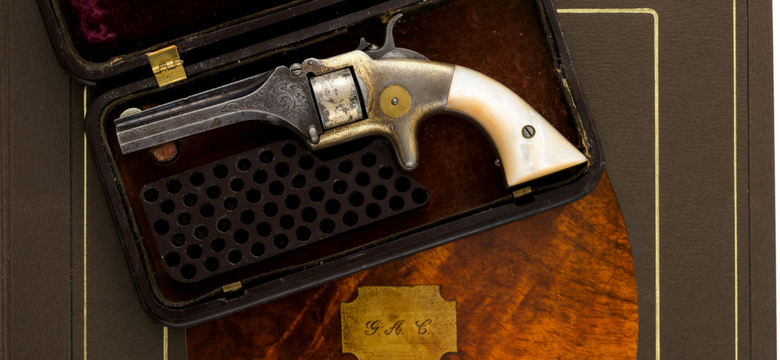For Garryowen and Glory! Those were the prophetic closing words of the regimental song of George Armstrong Custer’s 7th Cavalry.
Buy, Value or Appraise Your Historical and Americana Memorabilia
Bid or buy historical and Americana memorabilia for sale, value your item, or request a free appraisal to sell your collection.
As a boy growing up in the days of black-and-white TV, my favorite “old movie” was They Died with their Boots On, starring the incomparable swashbuckler Errol Flynn as Custer.
I watched it countless times. Who could forget the catchy tune played over and over during the film, or the image of Custer, the last man standing, blazing away, six-gun in each hand, as he was ridden down by a horde of Indians? Eventually I would have to unlearn most of the contrived “history” related in the movie, but my disillusionment did little to discourage my fascination with the saga of Little Bighorn and Custer’s Last Stand.
Barely 200 men perished with Custer, a seemingly insignificant number when compared to the tens of thousands of casualties in other American battles. Why does the Little Bighorn saga still hold such fascination nearly a century and a half later? Undoubtedly, part of the allure lies in the fact that Custer was a genuine American hero long before the events of 1876. The youngest man to be made a general during the Civil War, he was famous for his exploits as a cavalry commander … as well as for his golden locks and flamboyant dress. After finishing dead last in his West Point class, Custer certainly made his mark. During the decade before Little Bighorn, he led the 7th Cavalry as they fought Indians and explored new territory with the Yellowstone and Black Hills Expeditions. By the time of the disastrous battle in 1876, he was a celebrity and a household name.
Further adding to the drama was the possibility that personality traits and conflicts played a role. Was Custer brash and irresponsible in rushing to attack the large Indian encampment, or was he simply acting on what he thought was reliable military intelligence? Was the failure of Capt. Frederick Benteen to come to Custer’s aid a sound military decision, or was he influenced by his well-known personal distaste for his commander? Was Major Reno’s retreat after initially assaulting the village an example of cowardice, or an unavoidable response in the face of unanticipated, overwhelming resistance?
Lastly, there was the epic significance of a number of Plains tribes and bands coming together for one last, great celebration of their vanishing way of life, and to make a final valiant stand against the inevitable encroachment of “civilization.” It is now known that the Indians in the camp were aware of the soldiers’ approach, but failed to scatter as had been their tactic in the past. Instead, they waited almost passively for the great confrontation, knowing full well that, even if they managed to win the battle, they already had lost the war.
It is our great honor to bring to you an amazing auction June 9, a sale focused on those historic events and the personalities associated with them, titled “George Armstrong Custer and the Plains Indian Wars.” We are especially gratified to present the important artifacts and relics amassed by Glenwood J. Swanson, the highly respected Custer collector and scholar whose items make up a large portion of the auction. Glen is particularly appreciated for his ongoing support of archeological endeavors at the Custer Battlefield and for his landmark book, G. A. Custer His Life and Times, published in 2004. Lavishly illustrated, largely with items from his own collection, this book gives wonderful insights into Little Bighorn and the men who fought there.
There are SO many exciting and significant items that I can only encourage you to go to our website and peruse the entire 260-lot auction. Here are just a few examples:
Battle of the Little Bighorn Used
U.S. Springfield Model 1873 Trapdoor Carbine
Check out more Militaria & Civil War Memorabilia here!
Written by: Tom Slater
